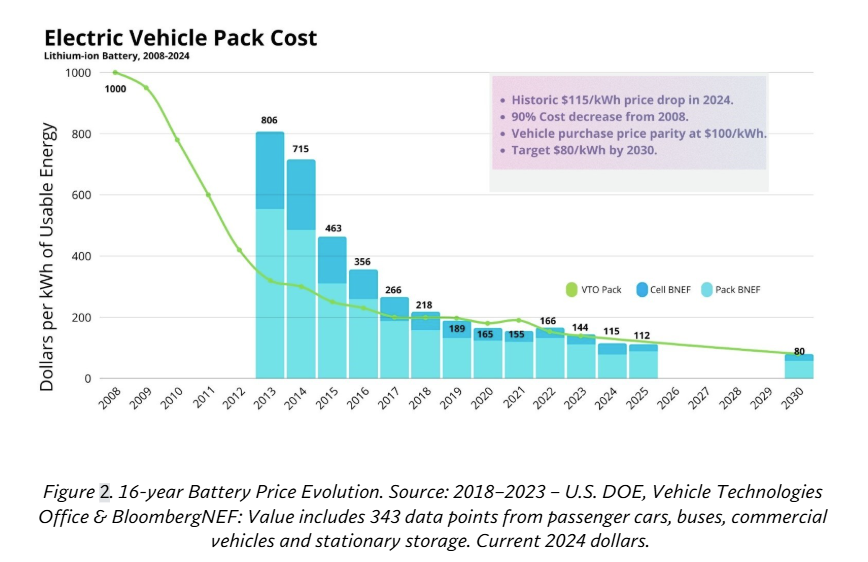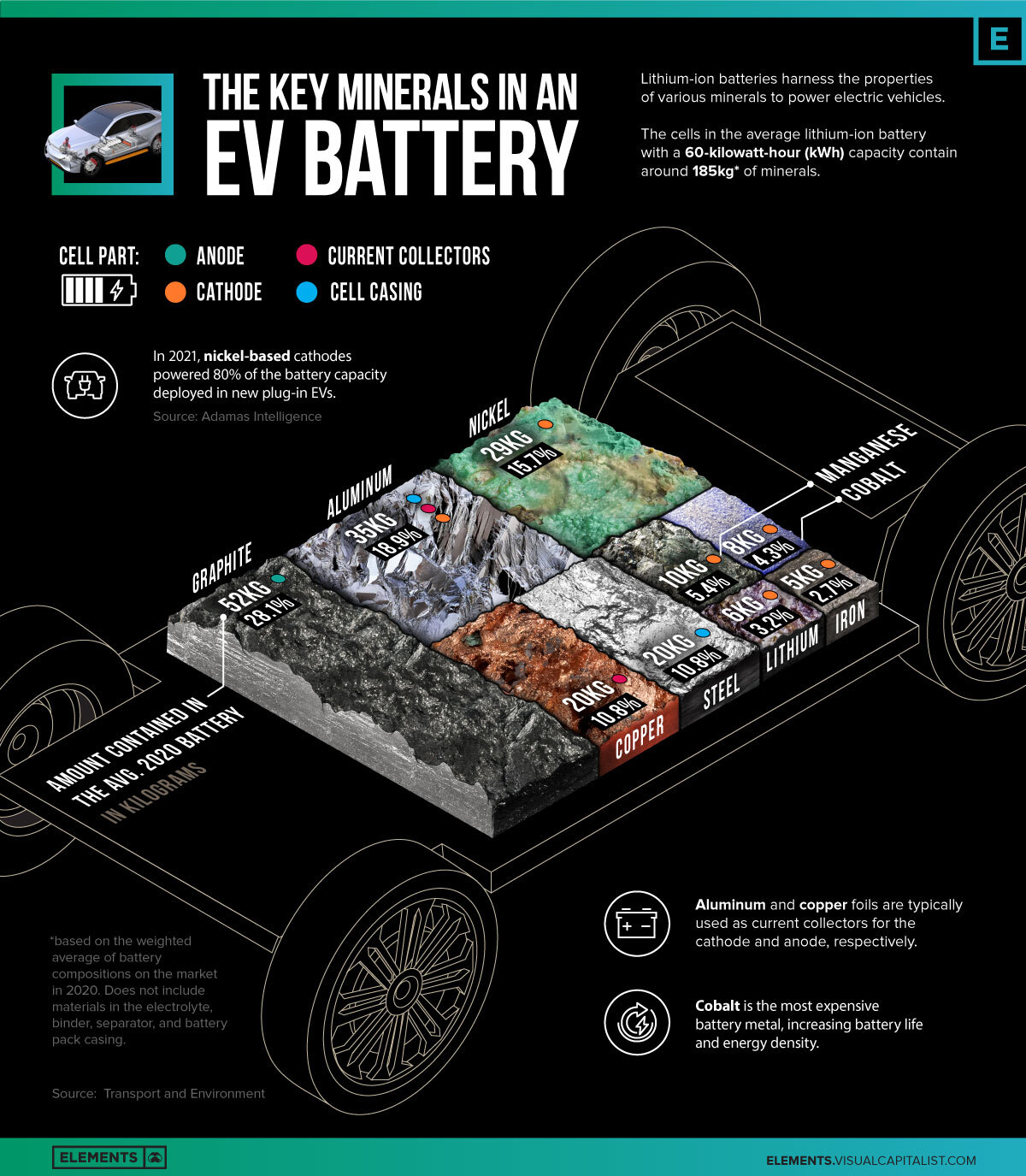Electric vehicles (EVs) are transforming the automotive industry, becoming more affordable and efficient while driving us toward a greener, more sustainable future. EVs are expected to be cheaper than gas vehicles by 2026, with battery prices predicted to fall by almost 50% (Goldman Sachs, October 2024). Let’s explore how EVs are becoming the best choice for a sustainable future and how their rapidly evolving technology advancements, manufacturing, and recycling efficiencies are shrinking their environmental footprint through shorter supply chains and scaling capacities to reuse materials.
Shorter, More Sustainable Supply Chain
One of the challenges with early EV production was the global nature of the supply chain. Materials for batteries often traveled long distances and were sourced from multiple regions worldwide. By the time a battery was assembled, its components had been all over the globe, adding weight to the carbon footprint of production.
However, this is changing fast. Automakers and battery manufacturers are localizing their supply chains, reducing transportation emissions significantly. For example, companies like Tesla, Ford, and Hyundai are retooling facilities in North America, ensuring battery production occurs closer to where the vehicles are sold. Hyundai’s new Metaplant in Georgia is a prime example, producing batteries and vehicles in one location to minimize its environmental impact. A $12.59 billion investment, along with 21 class-8 hydrogen trucks, will further reduce Hyundai’s EV manufacturing footprint (Hyundai, 2024).
This shift to localized supply chains is cutting down transportation emissions while also supporting ethical and sustainable sourcing practices. Complementing this effort, the introduction of EV battery passports is set to revolutionize transparency and sustainability in the industry. EV battery passports are digital records that provide detailed information about a battery’s origin, composition, and lifecycle. They track key data, such as the sourcing of raw materials, the carbon footprint of manufacturing, and the recycling processes involved after the battery's first life. This transparency helps manufacturers and consumers ensure that batteries are ethically and sustainably sourced while enabling better recycling and reuse of materials.
Volvo is already leading the way with the world’s first EV battery passport. These passports will ensure compliance with sustainability and ethical standards and pave the way for a more circular EV battery economy (Reuters, June 2024). According to McKinsey, this circular economy could reach a staggering $400 billion in market size with battery passports playing a critical role in streamlining supply chains and maximizing resource efficiency. Localized supply chains and EV battery passports are transforming the environmental impact of electric vehicles, making them cleaner and more sustainable long before they hit the road.
New Battery Technologies Mean Fewer Critical Minerals
Another reason EVs are getting cleaner lies in the evolution of battery technology and its chemistry. Most common lithium-ion batteries rely on critical minerals like cobalt and nickel, which are expensive to mine and have environmental and ethical challenges associated with their extraction.
With the increasing popularity of lithium-iron-phosphate batteries and advancements in battery management technology, reliance on these materials is dramatically decreasing.
LFP batteries leverage the use of readily available and less harmful materials. Unlike traditional lithium-ion batteries, LFP batteries do not use cobalt or nickel, and use a combination of lithium, iron, and phosphate, all of which are more abundant, easier to source, and less damaging to the environment.
Looking further ahead, solid-state (SSB) batteries are emerging as a groundbreaking innovation in EV technology. Solid-state batteries are a new type of battery that uses a solid electrolyte rather than the traditional liquid one found in lithium-ion batteries. This key difference allows for a battery with higher energy density, meaning it can store more power in a smaller, lighter package. This improves the range of electric vehicles and reduces the amount of raw material needed per battery (Bloomberg, October 2024). Most importantly, solid-state batteries rely on fewer critical minerals. Some designs eliminate cobalt and nickel entirely and replace them with more common and sustainable materials like lithium and sodium.
These improvements are not just hypothetical. For example, since 2022, Tesla has begun incorporating LFP batteries in certain models, while companies like Toyota invest heavily in solid-state technology. These advancements are driving down the environmental cost of battery production and making EVs an even more competitive choice for your next vehicle purchase.
Affordability
The advancements in EV battery technology, manufacturing processes, and recycling not only reduce the environmental impact of EVs but also make them increasingly affordable for everyday consumers.
Lower production costs, fewer expensive materials, and improved efficiencies have helped drive down the overall cost of EVs. The average price of electric car batteries has dropped by nearly 90% since 2010, helping to push down the overall price of EVs. According to BloombergNEF, the cost of lithium-ion batteries has fallen from $1,100 per kilowatt-hour in 2010 to $115 per kilowatt-hour by 2024.

This decline in battery costs is one of the key factors driving the increasing affordability of electric vehicles. This affordability has been a key factor in driving EV adoption in the U.S., which recently reached a major milestone: electric vehicles now make up over 5% of new car sales (Bloomberg, July 2022). This threshold is significant because it marks the tipping point when new technologies move from niche market to mass-market adoption. In other words, EVs are no longer just for early adopters, they're becoming mainstream and offer EV models with more features at competitive prices.
Recycling
Another significant advancement driving the sustainability of electric vehicles is the rapid growth of the battery recycling industry supporting the development of a circular economy for EV batteries.
The battery recycling sector has grown so rapidly that, according to recent reports, recycling capacity is expected to outstrip the supply of end-of-life EV batteries by a ratio of 4 to 1 by 2025 (The Driven, April 2024). This overcapacity signals that the industry is well-prepared to handle increasing volumes of retired batteries as EV adoption scales up. Companies like Redwood Materials and Li-Cycle are leading this effort, building robust recycling infrastructure that will be key in reducing reliance on raw materials.
Additionally, industry leaders like Cox Automotive provide end-to-end EV battery solutions. Their efforts focus on extending the life of batteries through reuse and eventually processing batteries to separate their core materials once the batteries reach the end of their life. By reclaiming critical materials, these industries help lower costs, reduce waste, and improve the overall efficiency of the EV supply chain.
Recycling is a game-changer for the EV industry, making the entire lifecycle of an electric vehicle far more sustainable. With advancements in recycling technology and growing infrastructure, the environmental footprint of EVs continues to shrink, solidifying their place as a key driver of a greener future.

